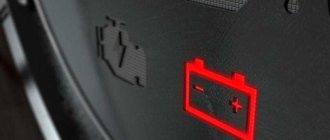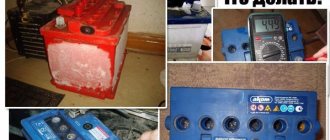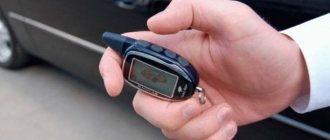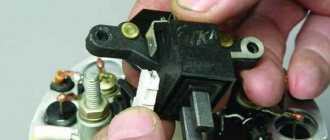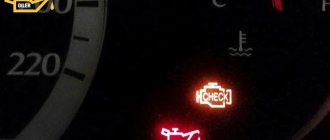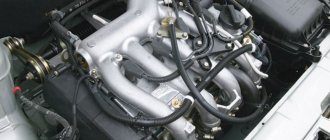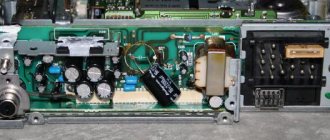Unfortunately, almost every car enthusiast has encountered a discharged battery. This is a very unpleasant event, even more unpleasant because, as a rule, it occurs in the morning. You approach your car, you have some plans for the day, for example, you urgently need to get to this or that place.
Get behind the wheel, turn the key in the ignition and nothing happens. As a result, you have to change your plans on the spot and somehow get out of the situation, because a car with a discharged battery is absolutely lifeless.
We will look at what to do and why this happens in this article.
The main reasons for battery drain
There are few reasons why a standard battery may be discharged, but any of them creates many problems, especially if it happens on the road. Let's consider the main ones:
- The battery is almost exhausted . In this case, even after a relatively short (night, day) parking, the battery capacity may drop to such an extent that there is not enough energy to start the engine even in the summer. In addition, even a fully charged but worn-out battery may only last a couple of starting attempts.
- The engine does not start well. In this case, we ourselves discharge the battery by repeated starting attempts. The matter can be aggravated by frost or the “stubbornness” of the driver, who “spins while he spins.”
- Additional energy-intensive appliances . Many motorists equip their car with additional equipment (powerful additional light, an audio system with a capacity of a couple of gigawatts, etc.), without thinking at all whether the standard generator will be enough to service all this and at the same time charge the battery.
- The generator or voltage regulator is faulty. If the voltage in the on-board network is too low, then the battery does not charge while driving or, even worse, discharges, trying to drain consumers. A couple of trips like this and the engine will no longer start.
- Forgetfulness. Until recently, this reason was very common - many motorists chronically forget to turn off their headlights after parking (for example, DRLs, dimensions, interior lights). After such inattention in the morning, most likely, the engine will not be able to start. Today, most machines have become “smart” and began to “warn” a person if he forgot to turn off the consumers. But, firstly, not all of the latter, but only those that are needed when the ignition is on. And, secondly, being installed abnormally and according to the wrong scheme, the same DRLs are not controlled by the car - they must be turned off manually.
- Using the battery while parked. We had a vigorous rest, listening to music and illuminating the parking lot with headlights, and were not interested in the amount of energy remaining in the battery. Result: the tents are folded, things are packed, but the engine cannot be started.
When organizing such a vacation, do not forget about constantly monitoring the condition of the battery.
What should we do if we find ourselves in one of the above situations? Look for a way out and try to start a car with a discharged battery.
Why you shouldn’t let your battery reach a deep discharge state
First of all, the question is related to the density of the electrolyte, which is ideally 1.27 g/cm3 in the ratio of water and sulfuric acid. As already mentioned, with a deep and prolonged discharge, the acid begins to settle on the electrodes in the form of salts.
But the danger is that deep deposits can remain on the electrodes forever. In this case, the battery may lose up to 30-40% of its original capacity. The process of salt precipitation is called sulfation, and it begins after the voltage drops to 11 V.
Basic launch methods
There are several methods for starting an engine with a dead battery. All of them more or less work, but, of course, you will have to choose based on the situation and possibilities.
How to properly light a cigarette from another car?
This is a popular method, but to implement it you need another car with a working battery - a donor. Using two large cross-section wires (16 mm² or more), the battery of a working car is connected in parallel to the dead battery of the recipient car.
This allows you to start the car from someone else's battery. But when using this method, you must follow a few simple rules. Otherwise, we will end up with two faulty cars.
In order not to damage the electrical equipment of the donor car, when “lighting up” the following rules must be observed:
- The standard voltage of the on-board network of the donor and recipient must be the same.
- The capacity of the donor battery must be no less than the capacity of the recipient battery.
- At the moment of “lighting up,” the donor engine must be turned off, the ignition is turned off, and consumers are turned off.
Important! There is an opinion that if the recipient is diesel, then a car with a gasoline engine cannot be used as a donor. This is absolutely false. If the capacity of the donor battery is not lower than the capacity of the recipient battery, then it does not matter what type of engine is installed in the cars. We only care about the current that the donor is capable of delivering.
The engine starting algorithm should look like this:
- We turn off the ignition on both cars and turn off all consumers.
- We connect the cable to the positive terminal of the donor battery.
- We connect the second end of the same cable to the positive terminal of the recipient battery.
- We connect the second cable to the negative terminal of the donor battery.
- We connect the second end of the cable to ground (the cleaned area of the body) or the negative terminal of the recipient battery.
- We start the recipient engine. If everything is done correctly and the donor battery is in good condition, the start-up will proceed without problems.
- Let the engine run for 5-10 minutes at a speed of about 1500 per minute.
- Without turning off the recipient's engine, disconnect the cables in the reverse order.
Expert opinion
Alexey Bartosh
Specialist in repair and maintenance of electrical equipment and industrial electronics.
Ask a Question
Important! Not all models and brands of cars can be started using this method. Some cars are so “smart” that they will immediately notice the substitution, and the on-board computer will not allow starting from someone else’s battery. But there are few of them, so this is a very realistic and feasible method in the vast majority of cases.
Read more about how to properly light a car.
What to do if there are no wires for lighting?
If we do not have special wires for “lighting” at our disposal, then, of course, we will not be able to use this method. But you can get out of the situation in this case too. We remove the battery from the donor and replace it with the recipient, having first removed the discharged battery from it. We start the engine, set the speed to about 1500 per minute, remove someone else’s battery, and connect ours. When the engine is running, the power supply to the on-board network is provided by the generator, so that at the moment of switching the engine will not stall.
Important! If we don’t have wires specifically designed for “lighting up”, then we use only this method. It is absolutely unacceptable to use homemade products made directly on the spot from improvised means, and even more so all kinds of crowbars, crowbars and other iron. This is very dangerous both for the health of the driver and for the condition of both cars.
No. 4 Warm water
If the vehicle is parked for several hours in low ambient temperatures, the battery may freeze. This does not mean the electrolyte will harden, but a slowdown in chemical reactions may well occur. It is better to warm up the battery by turning on the high beams for 1-2 minutes. But the disadvantage of this method is that part of the energy is spent on warming up, which may not be enough to turn the engine shaft with thickened oil.
Warming up the battery in a basin of hot water.
Therefore, some car owners warm up the battery in other ways. For example, warm water. This is not very effective, because the battery casing serves as excellent thermal insulation, and the inside of the battery will heat up (and cool down) slowly. But if this method is chosen, you should know that you cannot fill the housing up to the terminals. The water layer should be below the top panel of the battery. Another option is heating with water poured into plastic bottles.
The disadvantage of this path is that the additional thermal resistance of the walls of plastic containers will further reduce heat transfer. It is best to remove the battery in advance and take it to a warm room overnight.
Pushing launch
Another surefire way to start the engine if the battery in the car is dead and there is no suitable donor or starting device. To do this, you need to push the car and start the engine using the rotation of the wheels. You can literally push it manually, or you can use any other vehicle that will take the faulty car in tow.
How to start an engine with a seated battery using this method? There's nothing complicated about it. We put the gearshift knob in neutral and turn on the ignition. We open the door, get out of the car, the door remains open, we rest against the door pillar and push our faithful but sick “horse” as hard as we can. At the same time, we steer with one hand so as not to roll into the ditch. It’s very good if you can find a couple of assistants, and if the car is on a slope, then that’s generally great.
We pushed, while driving we jump into the driver’s seat, squeeze the clutch, engage second or third gear, release the clutch. The rotating wheels will crank the engine, and even a very discharged battery will have enough energy for the ignition system. As soon as the engine starts, the generator will start working. We stop and rev the engine at high speed for about 5 minutes. We set off and go about our business.
You will laugh, but the self-propelled gun was launched
If someone can “pull” us, then generally good. We cling to the “tractor” with a cable, turn on the ignition, depress the clutch, engage first gear and give the go-ahead to the “tractor” driver. As soon as we have accelerated slightly, release the clutch, start, depress the clutch, and disengage the gear. We stop while we unhook the cable; our battery will already be recharged a little. She will receive the rest of the energy during the ride.
Naturally, after such a start, you need to drive extremely carefully, without overloading the engine. If it stalls, you will have to push it again, since the battery will not gain the charge necessary to start the engine on its own in 10-15 minutes of driving. We'll have to push again.
Important. This method only works on cars with a manual transmission. It will not be possible to start the engine in a car with an automatic transmission.
Is resuscitation possible?
The battery can only be restored if acid sulfates are removed from the plates. There are a number of ways to do this:
- The plaque can be cleaned off manually by removing the plates from the battery. Afterwards it is necessary to replace the electrolyte. Read what the electrolyte level in the battery should be here.
- You can place the plates in a container with a special liquid - a desulfator. In this case, cleaning will happen instantly.
Important! When working, you must use PPE - rubber gloves and goggles.
For fans of “retro” - starting the engine using a “crooked starter”
Just 20 years ago, this method of starting the engine, which was popularly called “with a crooked starter,” was normal for a car with a dead battery. Today, not a single modern car is equipped with a mechanism that allows you to emergency start the engine using the starting (winding) handle. Progress, whatever you say. And if we have an automatic transmission, then you can’t push-start the car. It is not proper for boyars to turn handles and push cars. Nevertheless, in old cars such a handle was a great help and continues to help out.
Interesting! German armored vehicles from the Second World War had a flywheel-accumulator designed to start the engine with a discharged battery. To do this, there was a hole in the rear armor where the starting handle had to be inserted and turned, gradually increasing the rotation speed. When the flywheel spun, it was necessary to quickly pull out the handle, and then, using a special lever, engage the clutch of the inertial flywheel with the engine crankshaft.
Starting a tank using a “crooked starter” (reconstruction)
If our car is designed to start the engine in this way, then we simply put the gearshift knob in neutral and turn on the ignition. We install the “crooked starter” handle in place. We set it to “3 o’clock”, turn it quietly until about “6 o’clock”, focusing on the maximum resistance. Then, with a short jerk, we turn the handle forward until about 12 o’clock. If you fail to start the engine the first time, repeat the operation.
Using this method, we follow one simple rule - do not cover the starting handle with a hand with an opposable thumb. All fingers should be on the same side of the handle. That is, we do not grab the handle “in a fist”, but grab it with a “hook” from our fingers. This way, if the engine detonates, we won't lose our thumb.
When starting manually, grab the handle only this way
Is it possible to start a car using a similar method if it does not have a starting handle? Craftsmen found a way out of this situation. To do this you will need a jack and a strong rope or belt. Algorithm of actions:
- We install shoes under all the wheels of the car.
- We place a jack under the car so that one drive wheel is in the air: rear for rear-wheel drive, front for front-wheel drive.
- We wrap 2-3 turns of rope around the circumference of the wheel.
- Turn on the ignition and first gear.
- With a sharp tug on the rope we force the wheel to spin as the car moves.
- If you fail to start the car the first time, repeat the operation.
In principle, the operation is simple, but it has some nuances:
- the method requires considerable muscular strength, and therefore not everyone can do it;
- You can only start a car with a manual gearbox this way.
Important! In addition to complexity, this method is also dangerous. By pulling the rope, it is very easy to drop the car from the jack. In addition, at the moment of the jerk, the rope can become overwhelmed and begin to wind around the wheel, at the same time catching the hands of the launcher. When performing such an operation, it is better to have a partner who, immediately after starting the engine, will disengage the clutch and press the brake pedal.
No. 9 Call a tow truck
If none of the starting methods without a battery is applicable in the current situation, the only option left is to evacuate the car using special equipment. The advantage of the method is its versatility - it does not depend on the nature of the breakdown and the design of the car. The downside is that the service is expensive, and you can’t call a tow truck in every area.
Evacuation of a faulty vehicle using special equipment.
Starting the engine when the battery has exhausted its energy reserve is troublesome and not always successful. It is much more effective to monitor the condition of the battery and try to avoid getting into such situations.
Using a stationary charger (ROM)
If trouble happens in an electrified garage, then the engine can be started using the so-called starting-charger (ROM). Such a device is a “two in one” - a charger that, if necessary, can briefly supply high current to the load, helping a dead battery to crank the engine.
It's easy to work with. We plug the device into a power outlet. We bring the charging current to a minimum, connect the ROM terminals to the battery, observing the polarity, and put the device handle in the “Start” position. We turn on the ignition and try to start.
Expert opinion
Alexey Bartosh
Specialist in repair and maintenance of electrical equipment and industrial electronics.
Ask a Question
Important! Most of these devices only help a discharged battery by adding their own “amps”. If the battery is deeply discharged, then without preliminary recharging (with the same device) it will not be possible to start the engine.
How to properly charge a completely discharged battery
If the battery is dead, you can try to charge it - perhaps it will still serve. The first thing to do is check the electrolyte level. The plates must be completely covered with it. Next you need to choose a charger. An automatic one is unlikely to work - the work of many such chargers begins with checking the battery voltage. If it is below normal, charging will not start. Therefore, you need a charger with manual mode. Perhaps a simple homemade one would be optimal, but always with current control.
Homemade charger.
The initial current should be 3..10 times lower than usual. So, for a battery of 60 A*hours, the optimal charging current will be 0.1 of the capacity - 6 amperes. For a deeply discharged one, it should not exceed 2 amperes, or even better – 0.5..0.6 amperes (but charging will take several 2..4 days). In this mode, the battery must be charged until the threshold of 10.6..11 volts is reached, and then charged as usual. At the end of the procedure, it is useful to monitor the condition of the electrolyte (level and density), if necessary, bring the parameters to normal by adding distilled water or electrolyte, as appropriate. It’s also a good idea to immediately carry out a control and training cycle with measuring the actual capacity. Based on its results, a decision is made on the further suitability of the battery for use.
For clarity, we recommend a video.
Preheat
The operation of a lithium-ion battery is based on the internal movement of lithium ions. When a 100% charged battery is in a hot environment (in the heat), it receives an additional charge. An overcharging phenomenon occurs. This is because the lithium ions inside the battery gain additional energy from the heat (similar to the molecules in boiling water).
And vice versa, when a battery is placed in the cold, part of its energy is lost due to a decrease in the energy mobility of ions. Taking these phenomena into account, a rather ingenious, but based on quite reasonable basis, method of removing a battery from a deep discharge at home appears. Its essence is that the “dormant” battery needs to be heated. Then its ions, having received additional internal energy, will bring the readings from the terminals to a higher level.
However, you need to take into account:
- The degree of heating should correspond to the initial degree of remaining charge of the battery (that is, the deeper the discharge, the greater the heating);
- Heating should not be intense;
- Do not use open flame or heat, or boiling water;
- The battery should heat up all at once, and not in parts (sides).
A good way to heat evenly and smoothly is to use a hair dryer.
Fast charging method
If you have a portable charger on hand, on which you can adjust the current indicator, you can quickly recharge the battery with its help. To do this, you should charge the battery as usual, just keep it for no more than 15-20 minutes, setting the current to no more than 10 percent of the nominal battery capacity.
The method always works, but it cannot be called useful for a battery: the battery may lose a significant amount of capacity . Therefore, it is recommended to use it only in emergency cases.

